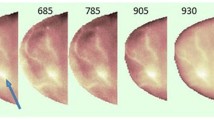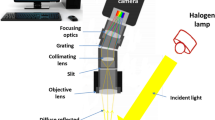Abstract
Background
Fluorescence spectroscopy is an evolving technology that can rapidly differentiate between benign and malignant tissues. These differences are thought to be due to endogenous fluorophores, including nicotinamide adenine dinucleotide, flavin adenine dinucleotide, and tryptophan, and absorbers such as β-carotene and hemoglobin. We hypothesized that a statistically significant difference would be demonstrated between benign and malignant breast tissues on the basis of their unique fluorescence and reflectance properties.
Methods
Optical measurements were performed on 56 samples of tumor or benign breast tissue. Autofluorescence spectra were measured at excitation wavelengths ranging from 300 to 460 nm, and diffuse reflectance was measured between 300 and 600 nm. Principal component analysis to dimensionally reduce the spectral data and a Wilcoxon ranked sum test were used to determine which wavelengths showed statistically significant differences. A support vector machine algorithm compared classification results with the histological diagnosis (gold standard).
Results
Several excitation wavelengths and diffuse reflectance spectra showed significant differences between tumor and benign tissues. By using the support vector machine algorithm to incorporate relevant spectral differences, a sensitivity of 70.0% and specifcity of 91.7% were achieved.
Conclusions
A statistically significant difference was demonstrated in the diffuse reflectance and fluorescence emission spectra of benign and malignant breast tissue. These differences could be exploited in the development of adjuncts to diagnostic and surgical procedures.
Similar content being viewed by others
References
Ramanujam N. Fluorescence spectroscopy of neoplastic and nonneoplastic tissues.Neoplasia 2000;2:89–117.
Richards-Kortum R, Sevick-Muraca E. Quantitative optical spectroscopy for tissue diagnosis.Annu Rev Phys Chem 1996;47:555–606.
Wagnieres GA, Star WM, Wilson BC. In vivo fluorescence spectroscopy and imaging for oncological applications.Photochem Photobiol 1998;68:603–32.
Mitchell MF, Cantor SB, Ramanujam N, Tortolero-Luna G, Richards-Kortum R. Fluorescence spectroscopy for diagnosis of squamous intraepithelial lesions of the cervix.Obstet Gynecol 1999; 93:462–70.
Mycek MA, Schomaker KT, Nishioka NS. Colonic polyp differentiation using time-resolved autofluorescence spectroscopy.Gastrointest Endosc 1998;48:390–4.
Zheng W, Lau W, Cheng C, Soo KC, Olivo M. Optimal excitation-emission wavelengths for auto fluorescence diagnosis of bladder tumors.Int J Cancer 2003;104:477–81.
Hirsch FR, Prindiville SA, Miller YE, et al. Fluorescence versus white-light bronchoscopy for detection of preneoplastic lesions: a randomized study.J Natl Cancer Inst 2001;93:1385–91.
Gillenwater A, Jacob R, Ganeshappa R, et al. Noninvasive diagnosis of oral neoplasia based on fluorescence spectroscopy and native tissue autofluorescence.Arch Otolaryngol Head Neck Surg 1998;124:1251–8.
Alfano RR, Pradhan A, Tang GC, Wahl SJ. Optical spectroscopic diagnosis of cancer and normal breast tissues.J Opt Soc Am B 1989;6:1015–23.
Yang Y, Katz A, Celmer EJ, Zurawska-Szczepaniak M, Alfano RR. Optical spectroscopy of benign and malignant breast tissues.Lasers Life Sci 1996;7:115–27.
Yang Y, Katz A, Celmer EJ, Zurawska-Szczepaniak M, Alfano RR. Fundamental differences of excitation spectrum between malignant and benign breast tissues.Photochem Photobiol 1997;66: 518–22.
Yang Y, Celmer EJ, Koutcher JA, Alfano RR. UV reflectance spectroscopy probes DNA and protein changes in human breast tissue.J Clin Laser Med Surg 2001;19:35–9.
Bigio IJ, Bown SG, Briggs G, et al. Diagnosis of breast cancer using elastic-scattering spectroscopy: preliminary clinical results.J Biomed Opt 2000;5:221–8.
Palmer GM, Zhu C, Breslin TM, Xu F, Gilchrist KW, Ramanujam N. Comparison of multiexcitation fluorescence and diffuse reflectance spectroscopy for the diagnosis of breast cancer.IEEE Trans Biomed Eng 2003;50:1233–42.
Etemad K, Chellappa R. Separability-based multiscale basis selection and feature extraction for signal and image classification.IEEE Trans Image Processing 1998;7:1453–65.
Yue W, Lan L, Freedman MT, Sun Yuan K. Probabilistic principal component subspaces: a hierarchical finite mixture model for data visualization.IEEE Trans Neural Networks 2000;11:625–36.
Burges C. A tutorial on support vector machines for pattern recognition.Data Mining Knowledge Discovery 1998;2:121–67.
Gunn S. Support vector machines for classification and regression. Available at:http://www.ecs.soton.ac.uk/~srg/publications/pdf/SVM.pdf Southampton, UK: University of Southampton, Department of Electronics and Computer Science: 1998.
Ramanujam N. Fluorescence spectroscopy in vivo. In: Meyers R. ed.Encyclopedia of Analytical Chemistry. New York: Wiley, 2000:20–56.
Ramanujam N, Mitchell MF, Mahadevan-Jansen A, et al. Cervical precancer detection using a multivariate statistical algorithm based on laser-induced fluorescence spectra at multiple excitation wavelengths.Photochem Photobiol 1996;64:720–35.
Author information
Authors and Affiliations
Corresponding author
Rights and permissions
About this article
Cite this article
Breslin, T.M., Xu, F., Palmer, G.M. et al. Autofluorescence and diffuse reflectance properties of malignant and benign breast tissues. Annals of Surgical Oncology 11, 65–70 (2004). https://doi.org/10.1007/BF02524348
Received:
Accepted:
Issue Date:
DOI: https://doi.org/10.1007/BF02524348




